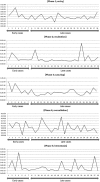Learning curve of minimally invasive two-port laparoscopic myomectomy
- PMID: 22906339
- PMCID: PMC3407431
- DOI: 10.4293/108680812X13291597716267
Learning curve of minimally invasive two-port laparoscopic myomectomy
Abstract
BACKGROUND AND OBJECTS: To examine the learning curve of minimally invasive 2-port total laparoscopic myomectomy (TTLM).
Methods: TTLM was performed by using only umbilicus and left inguinal ports, for 30 patients at our university affiliated hospital between May 2009 and February 2010. The times required for each of the 5 surgical phases of the early and late cases performed by the same surgeon were compared by using a DVD time counter.
Results: The mean surgical time was 82.5±5.2 minutes, blood loss was 42.1±7.5mL, and weight of specimen was 65.3±13.3g. The eighth case was the first in which the surgical time fell below the overall mean surgical time. Comparison of the mean time of each phase between the 7 early and the subsequent (late) cases revealed significant differences in the times required for suturing.
Conclusions: Although this was a feasibility study, the results suggest that this technique can be mastered after 7 cases. Learning curve, Suturing.
Figures




Similar articles
-
Single port laparoscopic myomectomy with intracorporeal suture-tying and transumbilical morcellation.Eur J Obstet Gynecol Reprod Biol. 2014 Oct;181:200-4. doi: 10.1016/j.ejogrb.2014.07.051. Epub 2014 Aug 8. Eur J Obstet Gynecol Reprod Biol. 2014. PMID: 25150961
-
Efficacy of 2-port laparoscopic surgery for gynecologic disease: invention of new suture technique.Fukushima J Med Sci. 2014;60(2):149-53. doi: 10.5387/fms.2014-16. Epub 2014 Nov 19. Fukushima J Med Sci. 2014. PMID: 25410442
-
Developments in techniques for laparoscopic myomectomy.JSLS. 2007 Jan-Mar;11(1):34-40. JSLS. 2007. PMID: 17651554 Free PMC article.
-
The role of laparoscopic myomectomy in the management of uterine fibroids.Curr Opin Obstet Gynecol. 2011 Aug;23(4):273-7. doi: 10.1097/GCO.0b013e328348a245. Curr Opin Obstet Gynecol. 2011. PMID: 21666469 Review.
-
[Laparoscopic myomectomy: indications and limits].Ceska Gynekol. 2007 Jan;72(1):64-8. Ceska Gynekol. 2007. PMID: 17357353 Review. Czech.
Cited by
-
In Laparoscopic Myomectomy, Does a Caseload of 100 Patients During the Learning Curve Produce a Significant Improvement in Performance Measures?J Obstet Gynaecol India. 2016 Oct;66(Suppl 1):422-7. doi: 10.1007/s13224-015-0782-x. Epub 2015 Oct 16. J Obstet Gynaecol India. 2016. PMID: 27651641 Free PMC article.
References
-
- Romanelli JR, Earle DB. Single-port laparoscopic surgery: an overview. Surg Endosc. 2009;23:1419–1427 Epub 2009 Apr 4. Review - PubMed
-
- Chamberlain RS, Sakpal SV. A comprehensive review of single-incision laparoscopic surgery (SILS) and natural orifice transluminal endoscopic surgery (NOTES) techniques for cholecystectomy. J Gastrointest Surg. 2009;13(9):1733–1740 Epub 2009 May 2. Review - PubMed
-
- Lim MC, Kim TJ, Kang S, et al. Embryonic natural orifice transumbilical endoscopic surgery (E-NOTES) for adnexal tumors. Surg Endosc. 2009. November;23(11):2445–2449 - PubMed
-
- Merchant AM, Cook MW, White BC, et al. Transumbilical Gelport access technique for performing single incision laparoscopic surgery (SILS). J Gastrointest Surg. 2009;13(1):159–162 - PubMed
-
- Nguyen NT, Reavis KM, Hinojosa MW, et al. A single-port technique for laparoscopic extended stapled appendectomy. Surg Innov. 2009. March;16(1):78–81 - PubMed
MeSH terms
LinkOut - more resources
Full Text Sources
Medical
